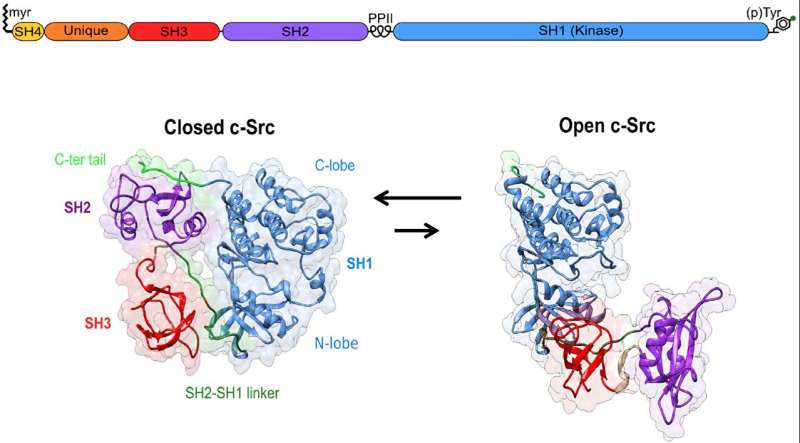This article has been reviewed according to Science X's editorial process and policies. Editors have highlighted the following attributes while ensuring the content's credibility:
fact-checked
peer-reviewed publication
proofread
Targeting the Src N-Terminal regulatory element in cancer

A new research perspective was published in Oncotarget, titled "Targeting the Src N-terminal regulatory element in cancer."
The signaling pathways displayed by cancer cells are often composed of the same components as the physiological ones, yet the overall result is a pathological deregulation. In this new paper, researchers Betlem Mezquita, Marjorie Reyes-Farias and Miquel Pons from the Universitat de Barcelona and Universitat Internacional de Catalunya discuss the non-receptor protein tyrosine kinase Src as a good example.
"Src, the first discovered oncogene, is the leading member of the Src family of kinases (SFK) that includes Fyn, Yes, Blk, Yrk, Fgr, Hck, Lck, and Lyn," say the researchers.
Src is the first described proto-oncogene and a demonstrated player in cancer progression, as it affects proliferation, invasion, survival, cancer stemness, and drug resistance. Src activation is linked to poor prognosis in many cancer types, yet mutations in this protein are rarely observed. In addition, being a demonstrated cancer target, unspecific inhibition of the kinase activity has proven inefficient in clinics since the inhibition of Src in non-cancerous cells results in unacceptable toxicity.
Thus, there is a need for new target regions in Src that could inhibit Src activity only in certain cell types, e.g., cancer cells, while maintaining the normal physiological activity in healthy cells. The Src N-terminal regulatory element (SNRE) includes the poorly studied intrinsically disordered region with unique sequences for each of the members of the Src family. In this perspective, the researchers discuss the non-canonical regulatory mechanisms involving the SNRE and their potential use as oncotargets.
"Our group has designed a screening system to search chemical libraries for binders of the Src SNRE [88] and we are currently following up a promising lead," say the authors.
More information: Betlem Mezquita et al, Targeting the Src N-terminal regulatory element in cancer, Oncotarget (2023). DOI: 10.18632/oncotarget.28434


















